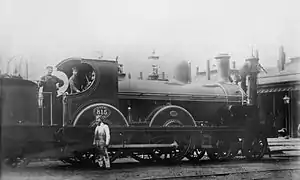L&YR Barton Wright 4-4-0
The Lancashire and Yorkshire Railway (L&YR) Barton Wright 4-4-0 was four-coupled eight-wheeled bogie express engine which entered service in 1880.
| L&YR Barton Wright 4-4-0 | |||||||||||||||||
|---|---|---|---|---|---|---|---|---|---|---|---|---|---|---|---|---|---|
 L&YR 815 built by Neilson in 1883 | |||||||||||||||||
| |||||||||||||||||
| |||||||||||||||||
| |||||||||||||||||
| |||||||||||||||||
| Notes:[lower-alpha 4][2] | |||||||||||||||||
Design and construction
Locomotive superintendent William Barton Wright ordered the first eight of the type in 1879 from Sharp Stewart and Company for the Hellifield−Chatburn line.[3]
Sharp Stewart supplied a further 16 in 1881 with Neilson and Company supplying 20 in 1883 and 10 in 1884, the latter having Joy valve gear.[4] The final batches Barton Wright batches went back to link motion: 20 from Kitson & Co. in 1885 and 20 from Vulcan Foundry up to 1886.[4] Following Barton Wright's resignation and John Apsinall's appointment the final 16 ordered from Vulcan Foundry delivered in 1887 had 4 in longer wheelbase between the driving wheels, Timmis springs on the eight axles, and bogie wheels reduced to 3 feet 0 inches (0.91 m) permitting straight main frames and a horizontal grate.[5]
Subsequent developments based on the design were the Aspinall L&YR Class 2 of which 30 were ordered from Beyer Peacock with Joy valve gear and 160 psi boilers and other variations and the L&YR Class 3 with 7 feet 3 inches (2.21 m) driving wheels.[6]
Service
The 6 feet 0 inches (1.83 m) driving wheels were suited to more challenging routes but on a non arduous route the Ramsbottom 2-4-0s could be faster.[7] Smaller tenders were initially necessary until bigger turntables were installed.[7]
Most were withdrawn in the early 1900s with only two, Nos. 922 and 924 going past 1914 to be classified Class 2 by Hughes in 1919 and passing by amalgamation into the LNWR and finally becoming London Midland and Scottish Railway Nos. 10100 and 10101 respectively before withdrawal in November 1930.[8]
1887 Royal Jubilee Exhibition
One of the final Vulcan Foundry batch with 3 ft bogie wheels batch was exhibited at the Royal Jubilee Exhibition, Manchester 1887.[9][10]
Notes
- Including Vulcan Foundry ordered by Aspinall but excluding Beyer Peacock and later
- Figure applies to later Sharp Stewart Locomotives
- Only two survived past 1914
- As originally built
References
- Bulleid (1967), p. 103.
- Marshall (1972), p. 93,238–240.
- Marshall (1972), p. 92−93.
- Marshall (1972), p. 93−94.
- Marshall (1972), p. 94.
- Marshall (1972), pp. 129,131,137–138.
- Marshall (1972), p. 93.
- Marshall (1972), pp. 238–240,273.
- Bulleid (1967), p. 94.
- "Royal Jubilee Exhibition, Manchester 1887 : official catalogue". P 150/640 Lancashire and Yorkshire Railway Co., Hunts Bank, Manchester.
Bibliography
- Bulleid, H.A.V. (1967). The Aspinall Era. Ian Allan Ltd.
- Marshall, John (1972). The Lancashire & Yorkshire Railway, volume 3. Newton Abbot: David & Charles. ISBN 0-7153-5320-9.